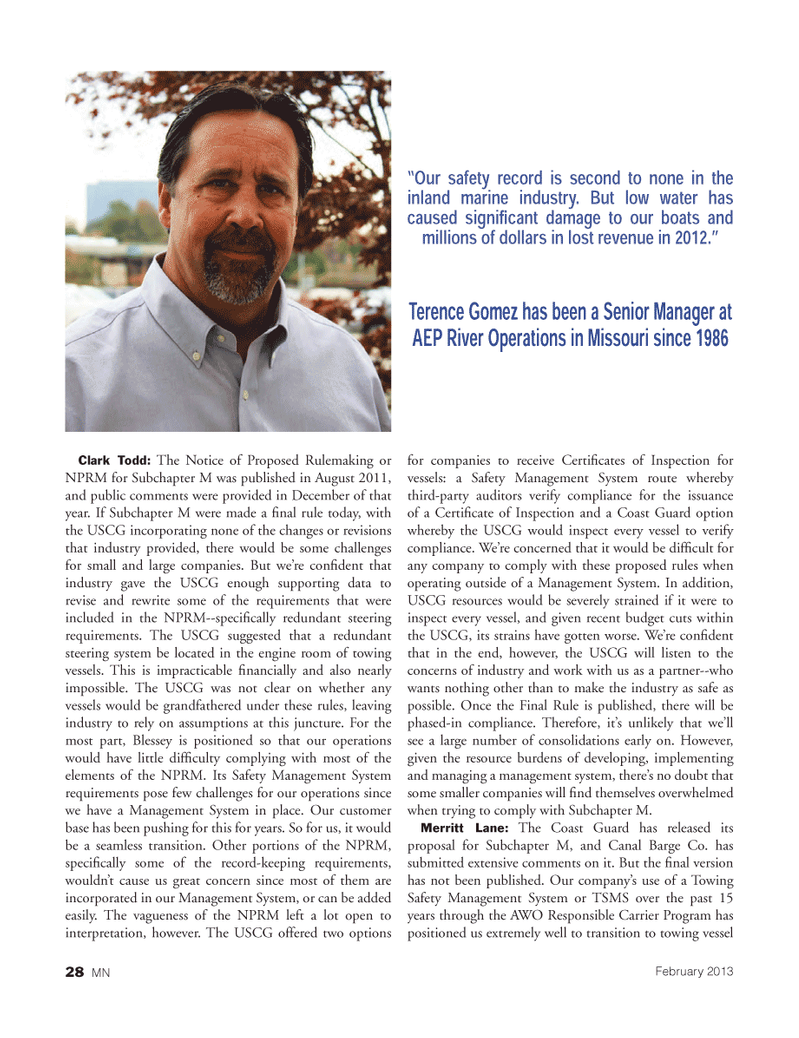
Page 28: of Marine News Magazine (February 2013)
Bulk Transport Leadership Roundtable
Read this page in Pdf, Flash or Html5 edition of February 2013 Marine News Magazine
Clark Todd: The Notice of Proposed Rulemaking or NPRM for Subchapter M was published in August 2011, and public comments were provided in December of that year. If Subchapter M were made a Þ nal rule today, with the USCG incorporating none of the changes or revisions that industry provided, there would be some challenges for small and large companies. But weÕre conÞ dent that industry gave the USCG enough supporting data to revise and rewrite some of the requirements that were included in the NPRM--speciÞ cally redundant steering requirements. The USCG suggested that a redundant steering system be located in the engine room of towing vessels. This is impracticable Þ nancially and also nearly impossible. The USCG was not clear on whether any vessels would be grandfathered under these rules, leaving industry to rely on assumptions at this juncture. For the most part, Blessey is positioned so that our operations would have little difÞ culty complying with most of the elements of the NPRM. Its Safety Management System requirements pose few challenges for our operations since we have a Management System in place. Our customer base has been pushing for this for years. So for us, it would be a seamless transition. Other portions of the NPRM, speciÞ cally some of the record-keeping requirements, wouldnÕt cause us great concern since most of them are incorporated in our Management System, or can be added easily. The vagueness of the NPRM left a lot open to interpretation, however. The USCG offered two options for companies to receive CertiÞ cates of Inspection for vessels: a Safety Management System route whereby third-party auditors verify compliance for the issuance of a CertiÞ cate of Inspection and a Coast Guard option whereby the USCG would inspect every vessel to verify compliance. WeÕre concerned that it would be difÞ cult for any company to comply with these proposed rules when operating outside of a Management System. In addition, USCG resources would be severely strained if it were to inspect every vessel, and given recent budget cuts within the USCG, its strains have gotten worse. WeÕre conÞ dent that in the end, however, the USCG will listen to the concerns of industry and work with us as a partner--who wants nothing other than to make the industry as safe as possible. Once the Final Rule is published, there will be phased-in compliance. Therefore, itÕs unlikely that weÕll see a large number of consolidations early on. However, given the resource burdens of developing, implementing and managing a management system, thereÕs no doubt that some smaller companies will Þ nd themselves overwhelmed when trying to comply with Subchapter M. Merritt Lane: The Coast Guard has released its proposal for Subchapter M, and Canal Barge Co. has submitted extensive comments on it. But the Þ nal version has not been published. Our companyÕs use of a Towing Safety Management System or TSMS over the past 15 years through the AWO Responsible Carrier Program has positioned us extremely well to transition to towing vessel ?Our safety record is second to none in the inland marine industry. But low water has caused signiÞ cant damage to our boats and millions of dollars in lost revenue in 2012.?Terence Gomez has been a Senior Manager at AEP River Operations in Missouri since 1986 February 2013 28 MNMN Feb2013 Layout 18-31.indd 28MN Feb2013 Layout 18-31.indd 281/30/2013 4:49:44 PM1/30/2013 4:49:44 PM

 27
27

 29
29
